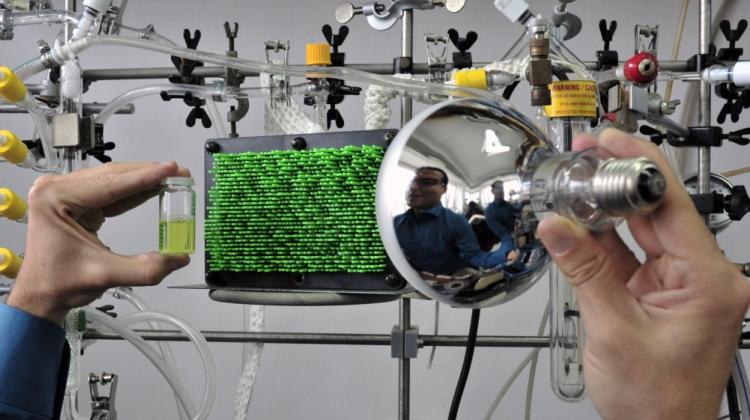Plantations of nanorods on graphene carpets capture the Sun's energy
 Innovative, three-dimensional photocatalyst, developed at the Institute of Physical Chemistry of the Polish Academy of Sciences in Warsaw and Fuzhou University in China, reacts mainly with visible light and activates new chemical bonds that store solar energy. The model in the picture shows the graphene surface (black plate) covered with zinc oxide nanorods (green rods). Source: Institute of Physical Chemistry PAS, Grzegorz Krzyżewski.
Innovative, three-dimensional photocatalyst, developed at the Institute of Physical Chemistry of the Polish Academy of Sciences in Warsaw and Fuzhou University in China, reacts mainly with visible light and activates new chemical bonds that store solar energy. The model in the picture shows the graphene surface (black plate) covered with zinc oxide nanorods (green rods). Source: Institute of Physical Chemistry PAS, Grzegorz Krzyżewski.
The innovative photocatalytic material that may accelerate chemical reactions, has been developed by a group of scientists from the Institute of Physical Chemistry of the Polish Academy of Sciences in Warsaw and Fuzhou University. Its use, for example in the pharmaceutical industry, will allow to accelerate the production of some compounds.
A group of scientists from the Institute of Physical Chemistry PAS in Warsaw and Fuzhou University developed an innovative photocatalytic material: stretches of zinc oxide nanorods, grown on a graphene substrate and "decorated" with cadmium sulphide dots. In the presence of sunlight, the combination zero-dimensional and one-dimensional semiconductor structures with two-dimensional graphene catalyses many chemical reactions - announced the Institute in a release sent to PAP.
The new photocatalytic material, developed by scientists from from the Institute of Physical Chemistry PAS in Warsaw and and the Department of Chemistry at Fuzhou University in China, looks like a strange forest under a microscope: simple, uniformly distributed trunks grow from a flat substrate, climbing up to the height measured in nanometers, where the "crowns" of semiconductor precipitates catch every ray of sun.
This innovative material is designed to ensure to provide the best possible cooperation between spot cadmium sulphide precipitates (so-called zero-dimensional structures) with zinc oxide nanorods (1D structures) and graphene (2D structure) during the processing of solar energy - reads the press release.
Methods of converting light energy reaching the Earth from the Sun can be divided into two groups. In the photovoltaic group, photons are used for direct generation of electricity.
Photocatalytic approach is different: radiation, both visible and ultraviolet, is used to activate the chemicals and reactions that store solar energy. This way, you can for example reduce carbon dioxide to methanol, synthesize fuel or produce valuable organic intermediates for chemical and pharmaceutical industries.
"The principle of action of the new, three-dimensional photocatalyst, developed by a group from the Institute of Physical Chemistry PAS and Fuzhou University, is simple. When a photon with sufficient energy falls on the semiconductor - zinc oxide ZnO or cadmium sulfide CdS - an electron-hole pair is formed. Under normal conditions, its recombination would virtually immediately occur, and solar energy would be lost. But in the new material electrons released in both semiconductors as a result of interaction with photons, quickly flow down along the nanorods to the graphene substrate, which is a great conductor.
Recombination may not occur, and the electrons can be used to create new chemical bonds and therefore for the synthesis of new compounds. The chemical reaction occurs on the graphene substrate, previously coated with organic materials to be processed" - reads the release.
Zinc oxide only reacts to ultraviolet radiation present in sunlight in an amount not exceeding a few percent. Therefore, researchers from the Institute of Physical Chemistry PAS and Fuzhou University also covered the forests of nanorods with cadmium sulphide precipitates. They react primarily with visible light, of which there is approx. 10 times more than UV - and act as the main supplier of electrons for chemical reactions.
"Our photocatalytic material works with high efficiency. We usually add it to processed compounds in a ratio of about 1:10. When exposed to sunlight, within no more than half an hour we process 80 percent, and sometimes even more than 90 percent substrate" - emphasised Prof. Yi-Jun Xu of the Department of Chemistry at Fuzhou University, China, where a large part of experimental research has been carried out.
"The great advantage of our photocatalyst is the ease of its production" - noted Dr. Juan Carlos Colmenares from the Institute of Physical Chemistry PAS.
"Graphene suitable for applications in photochemistry is now readily available and inexpensive. The process we invented that involves coating graphene with plantations of zinc oxide nanorods, on which cadmium sulphide precipitates are then embeded, is fast, efficient, occurs at a temperature slightly higher from room temperature, at normal pressure, and it does not require any sophisticated substrates" - added Colmenares.
For applications on a wider scale it is important that the new photocatalyst wears slowly. The conducted experiments show that a slight decrease in reaction yield (approx. 10 per cent.) occurs after the sixth-seventh use.
Skillfully used, new 3D photocatalyst can significantly alter the course of chemical reactions. Its use, for example in the pharmaceutical industry, could reduce the number of stages of the production of certain pharmacological compounds from a dozen to just a few.
PAP - Science and Scholarship in Poland
zan/ krf/
tr. RL
Przed dodaniem komentarza prosimy o zapoznanie z Regulaminem forum serwisu Nauka w Polsce.














